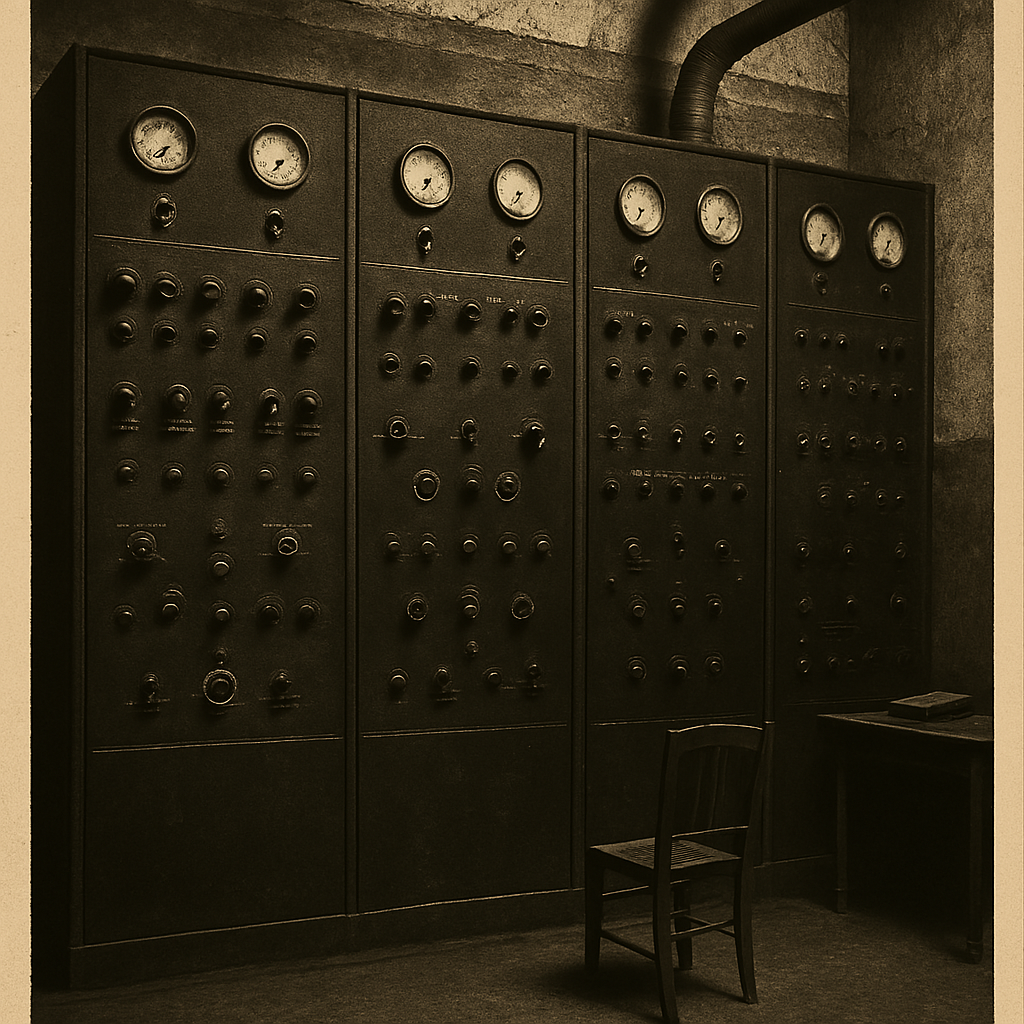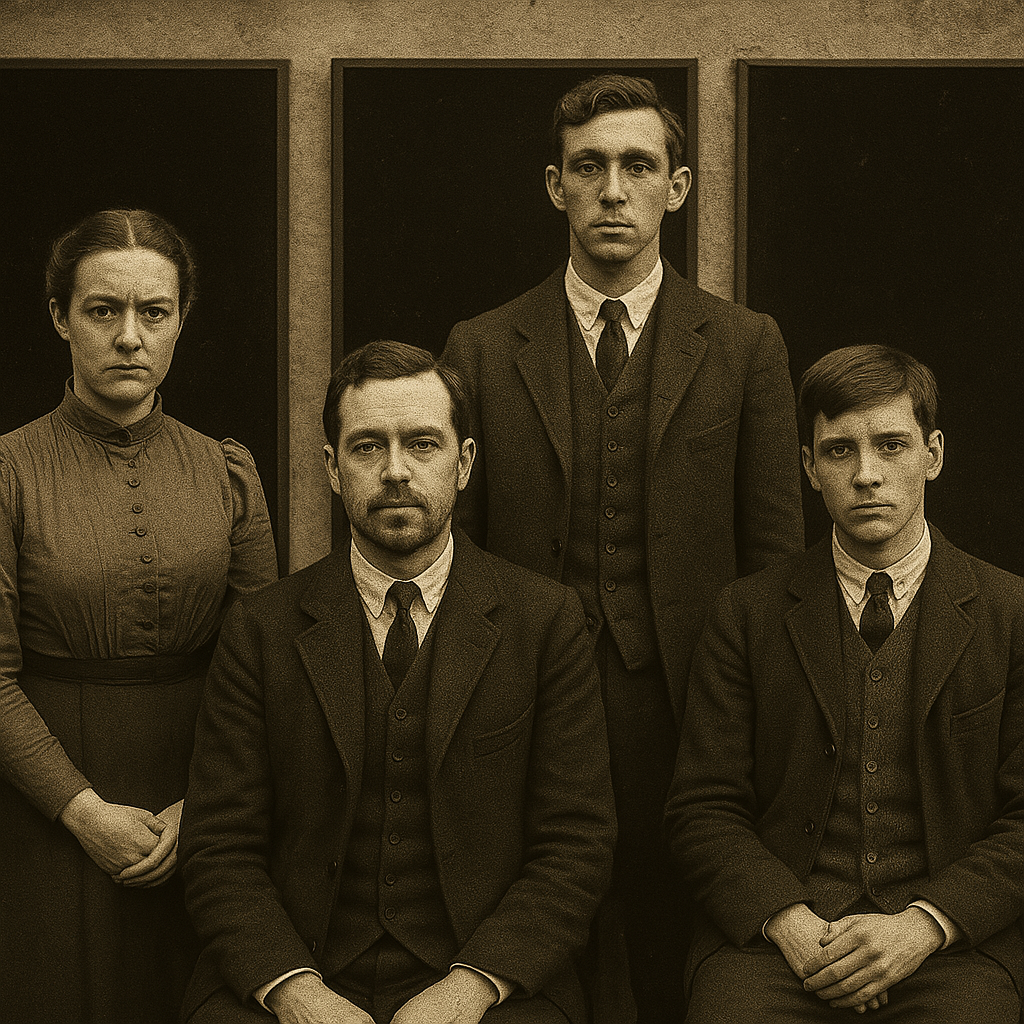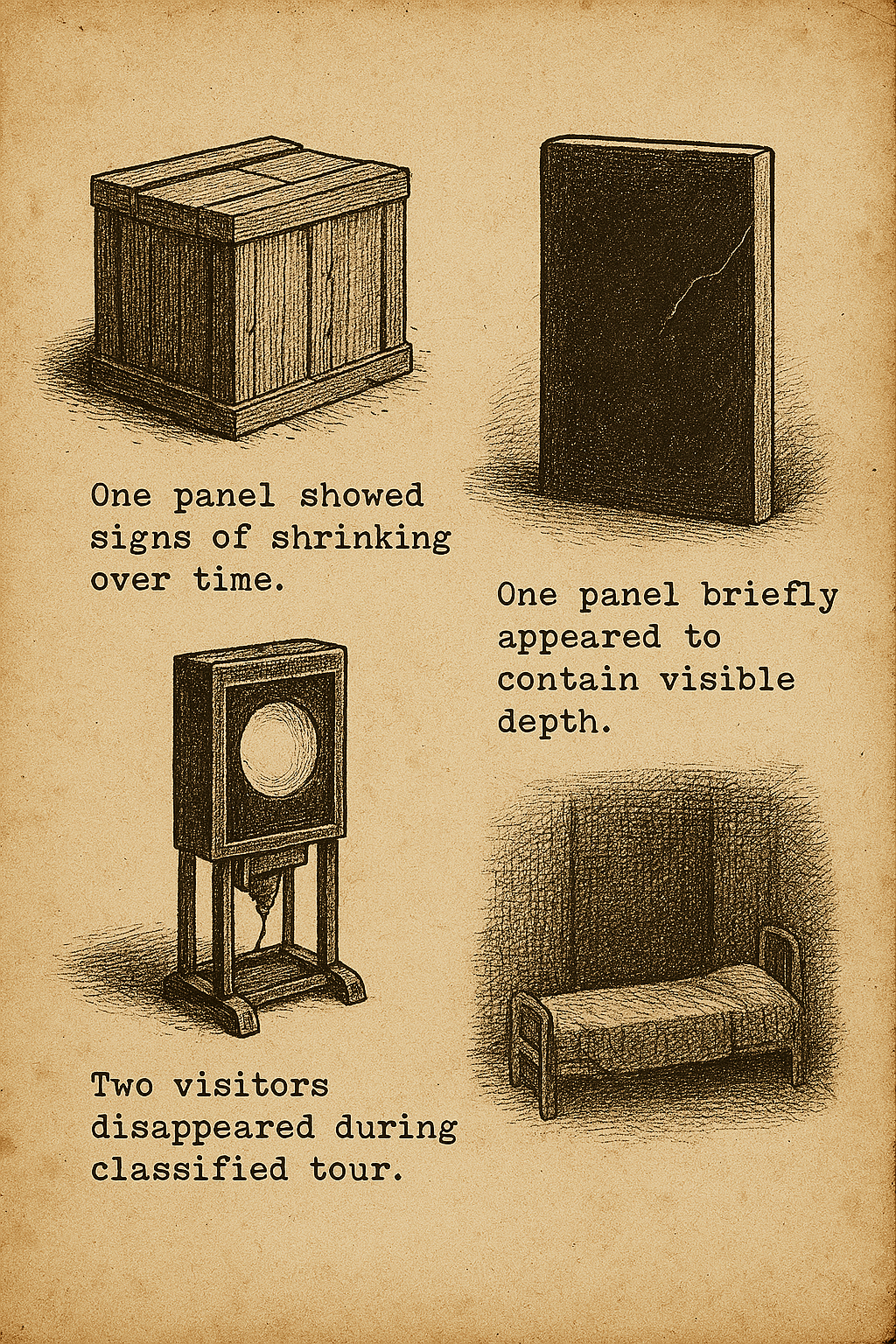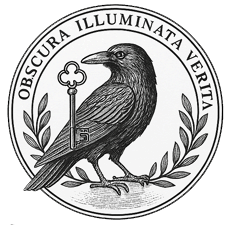Installed: Circa 1906–1907
Location: South Wing, Observation Level 2
Material Composition: [UNKNOWN]
Status: Restricted Containment | Access Revoked 1921
Danger Classification: Level V – Perceptive Interference

This 1907 sepia-toned photograph captures a rare glimpse of the so-called Black Panels, a sequence of smooth, opaque wall fixtures installed along the lower corridor of StormCroft’s South Wing. Believed to absorb rather than reflect light, the panels were reportedly warm to the touch and emitted a low frequency hum on certain days of atmospheric pressure shift. No documentation exists on their purpose or construction. Staff assigned to maintenance of this corridor often reported a sense of being “observed from the other side.”
Final entries in the 1984 logbooks mention five matte-black metal sheets discovered in the South Archive. When placed against any flat wall, they reflect back a room that is not the one they face. Believed to be a Wren/Finch legacy project. One panel vanished during inventory. One appears in a staff photograph from 1907. The others remain unaccounted for.
Description & Installation
The Black Panels were first recorded in internal memoranda in late 1906, though no formal order for their design, delivery, or installation exists in the StormCroft ledger. They appeared—almost overnight—along a stretch of corridor previously used for transit between the Resonance Storage Hall and the Mapping Room.
Each panel measured precisely 1.8 metres in height by 0.6 metres in width, mounted flush against the wall with no observable fastenings. The surface was featureless, non-reflective, and absorbed all available light, rendering it impossibly matte. Attempts to photograph the panels in full light failed — the areas remained perfectly black, regardless of exposure.
Despite their simplicity in form, the panels produced an immediate atmospheric shift in the corridor. Temperatures dropped slightly, and the air thickened with what one archivist called “the kind of quiet you only hear before something starts.”
Assigned Staff & Observations
A small team was established to monitor the panels beginning in March 1907, under the authority of Operations Overseer Giles Ambery. His selected group included:
-
Miss Adelaide Northwood – Archive Scribe
-
Peter Tovey – Acoustic Technician
-
Edward Marnham – Light Surveyor
-
Louis Brennet – Junior Observer

The team’s early reports were minimal — noting minor vibrations and the sound of whispering behind the panels during evening hours. Northwood’s logs recorded that Panel Four emitted a faint tapping rhythm between 3:00 and 3:05 AM for three consecutive nights, although no one else heard it.
On 17 May 1907, Tovey began to lose coordination in his right hand while passing Panel Seven. He described the sensation as “writing backwards through bone.” He was reassigned and left the estate weeks later.
By June, more serious disturbances were noted:
-
Edward Marnham fell into a prolonged waking dream state and began speaking in reversed sentences, referencing names unknown to StormCroft personnel.
-
Brennet refused to approach the corridor altogether, claiming he had seen a second version of himself in the reflection of Panel Two — though the panels reflected nothing.
-
Miss Northwood, who had grown increasingly erratic in tone, was found weeping outside the Mapping Room one morning. She held a blank page she insisted was a transcript of Panel Six’s thoughts. The page bore only the phrase:
“You remember what you haven’t done yet.”
Containment & Aftermath
On 13 August 1907, the corridor was sealed following what has only ever been referred to as The Silence Pulse. The surviving report by Overseer Ambery described:
“A complete nullification of sound and movement. Clocks stopped. Fluids ceased to pour. Ink stood upright in the nib. All twelve panels began to warm—identically—and within seven seconds the temperature in the corridor reached 42°C. Then, just as quickly, it dropped. One panel cracked. Or bent.”
Miss Northwood vanished that evening. No trace was found, though her logbook remained on her desk, open to the line:
“Some reflections do not wait for mirrors.”
By early 1908, the panels had been boxed in with iron reinforcement and lime-treated wood. Any maintenance logs after 1912 were blacked out or burned. In 1921, a final report was issued:
“Do not speak of the panels. Do not name them aloud. They remember.”
The panels remain — their current state unknown. The South Wing corridor was rerouted in 1949, and most staff are unaware that a passage even existed there.
Speculation & Unanswered Questions

A handful of surviving engineers and archivists have quietly shared further claims over the years:
-
That Panel Eleven showed signs of shrinking over time, becoming thinner with each recorded incident.
-
That one panel briefly contained a visible depth — as though the wall had opened inward, though the material remained unchanged.
-
That two visitors from GWR’s Signals Division went missing during a classified tour and their names were removed from station records entirely.
Several believe the Black Panels were not built at all — but rather grown or discovered, and the surrounding corridor was designed to mask them.
Others suggest they were a response — an echo of something future, fed by memory, attention, and the act of being looked at.
(image: Description: This technical ink illustration, drawn in sepia on aged ledger parchment, depicts several field instruments reportedly used by Observation Unit 3 during their work near the Black Panels.
Included are:
- A handheld tone-matching coil (believed to harmonise with residual hums)
- A light interference reader calibrated to detect non-visible shadow compression
- A notation grid with mirrored glyph overlays, used by Miss Northwood for transcribing reflections not visible to the eye
- A folding proximity dial designed to tick only in the presence of reflected intention
The image was recovered from an unauthorised duplication of StormCroft Operational Manual Vol. 7a, section marked:
“Field Tools – Apparatus no longer requiring assembly.”
Engineers later noted the measurements in the margin shift by 3mm when viewed under certain lighting conditions).
Final Directive
Do not attempt to examine or replicate the material of the Black Panels.
Do not return to the corridor.
Do not speak of them within line-of-sight of where they were.
Their surface does not reflect.
But it remembers.
